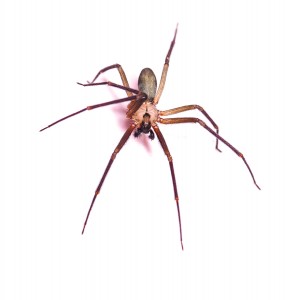Snakes, Bees, Spiders, and Ants… (Creepy things that bite our dogs)
 Kevin T. Fitzgerald, PhD, DVM, DABVP
Kevin T. Fitzgerald, PhD, DVM, DABVPStaff Veterinarian
VCA Alameda East Veterinary Hospital
Denver, Colorado
Often as veterinarians, we hear owners say about their animal’s undiagnosed ailment, “Maybe something bit him in the yard.” However, most people don’t even know what venomous animals live in Colorado that could bite or sting their pet. In this article we will examine the actual local creatures responsible for such injuries.
Snakes: People do not normally associate Colorado with reptiles but our state is home to 5 species of turtles, 18 types of lizards, and 26 different species of snakes. Thankfully, only 3 of the snake species here are venomous. Dangerous snakes include the prairie rattlesnake (Crotalus viridis) – the eastern slope of the Rockies and eastern plains, midget-faded rattlesnake (Crotalus concolor) – western and southwestern slope of the Rockies, and the massasauga or pygmy rattlesnake (Sistrurus catenatus) – southeastern plains of the state. Rattlesnakes are found throughout most of Colorado and can reach elevations of 7,500 to 8,000 feet. In eastern Colorado, prairie dog burrows are the major denning sites. This is a dangerous venomous snake. The hallmark of rattlesnake bites is tremendous swelling, hemorrhaging, bruising, and tissue destruction.
Dogs are usually bitten on the face. Any dog bitten should receive immediate veterinary care. Your best equipment following an envenomation to your dog is your cell phone. Call your veterinarian or the closest emergency veterinary hospital and inform them you are on your way. Although many dogs are bitten in Colorado each summer, with treatment the vast majority survive.
Spiders: Spiders are the world’s most successful terrestrial carnivore. There are 38,000 known species with some experts thinking there may be as many as 100,000 species. You are never more than one meter away from a spider in your lifetime. For all intents and purposes, all spiders are venomous, and their areno vegetarian spiders. In Colorado, the spiders most implicated in bites are the black widow (Lactrodectus mactans), the brown recluse (Loxosceles recluse), and the Chiracanthium species – the running spiders and “Commode” spider. Due to the small size of the spider, the hair of the dog, and the fact that the bite is rarely witnessed, the true incidence of spider bites in dogs is unknown. Although these can be painful, they do not swell like snakebites and bee stings. These are usually self-limiting, rarely fatal, and can be managed conservatively with warm baths, a steroid ointment, and pain medication. Nevertheless, if a spider bite is suspected, your veterinarian should be notified for instructions.
Bees: Bees are fascinating creatures and inhabit our state. They make honey – a perfect food, manufactured by nature and harvested by insects. Bees are vegetarians, have hairy bodies, and because they lose their hooked, barbed stinger, they die when they sting us. Wasps and hornets are carnivores, have smooth bodies, and do not lose their straight stinger making them able to sting multiple times. Stings hurt, generally quickly swell, but are non-life threatening as long as the person or animal is not allergic to bee stings. It is estimated that 1 to 3% of people and dogs are allergic to bee stings. Due to the dog’s coat, the stinger is rarely found, but recent research says that 100% of the venom is out of the stinger in 60 seconds, so don’t waste time searching for the stinger. Most bee stings in dogs can be treated conservatively with warm baths, steroid-containing ointments, and pain medication. Dogs experiencing anaphylaxis after a bee sting should seek immediate veterinary care. Dogs don’t seem to learn after being stung once.
Ants: As of this writing, fire ants have not been reported in Colorado. Nevertheless, old, debilitated dogs that lay outside should be routinely checked for infestation by native ants that can be severely damaging – under the tail, under ear flaps, and on the down side touching the ground. Newborn pups can also be victims.
It is helpful to know and recognize the venomous animals in your area. In known rattlesnake habitat, particularly next to prairie dog colonies, dogs should not be allowed to run at large. Spiders are usually secretive and favor dark, draftless areas (closets, attics, basements, etc.). Dogs should be restricted from these areas, too. Your veterinarian is as far away as the telephone. Consult with them if you suspect your dog has experienced a known bite or sting.







